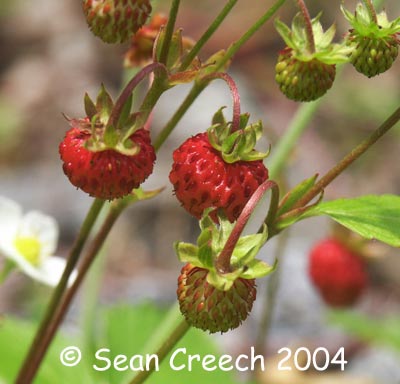 Description: The Wild Strawberry is a member of the rose family. The leaves of the Wild Strawberry plant have 3 toothed leaflets, and the flower has 5 white petals - the centre being a rich yellow colour. The unripened berries are green in colour, flaked with red. The ripened red fruit looks and smells very similar to that of a typical Strawberry plant, only the size much smaller, and the smell even more delicate. Most of the fruits are less than 1cm in diameter, so you will need to pick a lot to fill a basket. The fruit season is quite short, with no more than a month generally, July being the best bet.
Description: The Wild Strawberry is a member of the rose family. The leaves of the Wild Strawberry plant have 3 toothed leaflets, and the flower has 5 white petals - the centre being a rich yellow colour. The unripened berries are green in colour, flaked with red. The ripened red fruit looks and smells very similar to that of a typical Strawberry plant, only the size much smaller, and the smell even more delicate. Most of the fruits are less than 1cm in diameter, so you will need to pick a lot to fill a basket. The fruit season is quite short, with no more than a month generally, July being the best bet.Habitat: Growing wild, they are found from the lowest valleys, in moist soils of woods, open meadows and beside streams. Good crops can commonly be found alongside exposed railway tracks.
Edible and medicinal value: The fruit, leaves and roots have all been used as far back as one can remember, Saxon times refer to the "Straberie". The Western Indians made a tea from the green leaves, which also may have stopped Scurvy at it's worse times. Dried leave tea was used to relived stomach and kidney troubles. The fruit, containing amongst other things malic and citric acids, were eaten to lesson the likilhood of getting colds - and during them - naturally they contain a lot of Vitamin C. Juiced fruit was mixed with water and used to soothe reddened eyes, and inflamed sores - with apparent healing effects. It has also been used to relieve sunburn. A tea made from dried leaves was used for kidney trouble and relieving stomach trouble.
Perhaps one of the strangest uses was as toothpaste - where mashed fruits were put onto the teeth to remove tartar, and also for releive toothache. An old recipe states "The fruit removes dis-coloration of the teeth if it is allowed to remain on for about 5 minutes. The teeth should then be cleansed with warm water, to which a pinch of bicarb of soda has been added.". The roots have known to be used for diarrhoea.
Of course you could just eat them, with a little sugar and perhaps some ice cream. They'll make a great jam too.